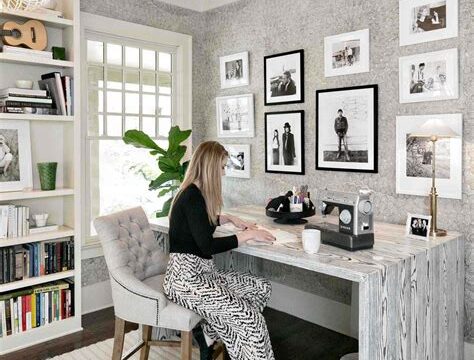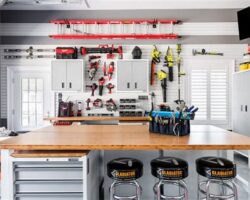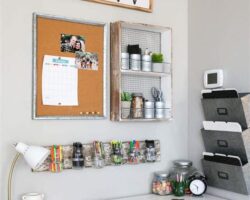Working from home has become the new normal for many, and for those in creative fields, having a home office that fosters productivity and inspiration is essential. In this blog post, we will explore how to design a home office specifically tailored for creatives – a space that not only encourages efficient work but also sparks artistic inspiration. From choosing the right color palette to incorporating artwork and decor, organizing supplies, and creating a comfortable workspace, we will cover it all. We’ll also discuss the role of lighting and natural elements in creating a calming and focused atmosphere. Whether you’re a writer, designer, artist, or any other creative professional, this guide will provide you with valuable insights and ideas for creating a home office that elevates your work and brings out your artistic best.
Creating a Space that Sparks Creativity
When it comes to designing a space that sparks creativity, it’s important to consider the overall ambiance and atmosphere of the room. The environment in which you work can have a significant impact on your creative capabilities. It’s essential to create a space that is visually stimulating and conducive to innovation.
Color palette plays a vital role in setting the tone for creativity. Bright and vibrant colors can energize and inspire, while softer, muted tones can promote a sense of calm and focus. Choosing the right color palette for your workspace can help create an environment that is both visually appealing and conducive to creative thinking.
Organizing your supplies and materials is another critical aspect of creating a space that sparks creativity. A clutter-free and well-organized workspace can help minimize distractions and promote productivity. Having easy access to your tools and materials can also streamline the creative process and help you stay in the flow.
Artwork and decor can also significantly impact the creative energy of a space. Incorporating pieces of artwork, inspirational quotes, and decorative elements that resonate with your personal style and creative vision can help infuse the room with a sense of inspiration and motivation.
Choosing the Right Color Palette for Inspiration
When it comes to creating an inspiring workspace, the color palette you choose can have a huge impact on your overall creativity and productivity. Certain colors have been proven to stimulate the mind and evoke specific emotions, making them perfect choices for a creative environment.
One important factor to consider when selecting a color palette for your workspace is the nature of the work you do. For example, if you are an artist or designer, you may want to incorporate bold and vibrant colors to spark your imagination. On the other hand, if your work requires a lot of focus and attention to detail, soothing and calming colors may be more beneficial.
Another key consideration when choosing a color palette for inspiration is the natural light in your workspace. Colors can appear differently in various lighting conditions, so it’s important to take this into account when making your selection. If your workspace receives a lot of natural light, you may have more flexibility with your color choices, whereas a space with limited natural light may require more thought and planning.
Ultimately, the right color palette for inspiration will be a personal choice that reflects your individual style and preferences. Whether you opt for bold and daring hues or calming and tranquil tones, the key is to create a space that energizes and motivates you to do your best work.
Organizing your Supplies for Maximum Productivity
When it comes to maximizing your productivity in a creative workspace, organization is key. Keeping your supplies neatly organized and easily accessible can make a world of difference in how efficiently you work. By clearing clutter and implementing a system for organizing your supplies, you can create a more efficient and inspiring work environment.
Start by sorting through your supplies and getting rid of anything that is no longer useful. This will help clear physical and mental space, allowing you to focus on the tasks at hand. Once you have pared down your supplies, consider investing in storage solutions such as bins, shelves, and organizers to keep everything tidy and within reach.
Having a designated place for each type of supply can help streamline your workflow and prevent time wasted searching for what you need. Consider labeling your storage containers to make it easy to find what you need at a glance. This attention to detail in organizing your supplies can have a big impact on your overall productivity.
Finally, make it a habit to clean and organize your workspace on a regular basis. Keeping everything in its proper place will not only make it easier to get to work, but it can also help spark inspiration and creativity. By taking the time to organize your supplies, you are setting yourself up for maximum productivity and creativity in your workspace.
Incorporating Artwork and Decor for Creative Stimulation
Incorporating Artwork and Decor for Creative Stimulation
When it comes to creating a space that fosters creativity, the incorporation of artwork and decor plays a crucial role. A well-designed workspace can inspire and stimulate creativity, and the right choice of artwork and decor can have a significant impact on the overall ambiance of the space.
The key is to choose pieces that resonate with your personal style and preferences. Whether it’s a vibrant painting, a unique sculpture, or a collection of decorative items, the artwork and decor you choose should reflect your individuality and spark inspiration.
One approach to incorporating artwork and decor for creative stimulation is to focus on pieces that evoke positive emotions and provoke thought. Selecting pieces that resonate with your interests and ignite your imagination can help create a space that encourages creative thinking and productivity.
Furthermore, the strategic placement of artwork and decor can also contribute to the overall aesthetic appeal of the space. By arranging pieces in a way that complements the layout of the workspace, you can create a visually stimulating environment that promotes creativity and innovation.
Designing a Functional and Comfortable Workspace
When it comes to creating a workspace that is both functional and comfortable, there are several key elements to consider. First and foremost, it’s important to choose a desk and chair that are ergonomically designed to support good posture and reduce the risk of discomfort and injury. Investing in a high-quality, adjustable chair and a spacious, sturdy desk is essential for maintaining productivity and physical well-being.
Another important factor to consider when designing a workspace is the layout and organization of the space. Having easy access to frequently used supplies and tools is crucial for efficiency, so incorporating storage solutions such as shelves, filing cabinets, and desk organizers can help keep your workspace tidy and your mind clear.
Lighting is also a key component of a functional workspace. Natural light is ideal for enhancing productivity and focus, so positioning your desk near a window can be beneficial. In addition, adding task lighting such as a desk lamp or adjustable overhead lighting can help reduce eye strain and improve visibility when working on detailed tasks.
Lastly, incorporating personal touches such as artwork, decor, and plants can help create a comfortable and inspiring ambiance in your workspace. Adding elements that reflect your personality and interests can enhance your overall well-being and productivity, making your workspace a place you enjoy spending time in.
Lighting Ideas to Enhance Creativity and Focus
Proper lighting can have a significant impact on your ability to focus and be creative in your workspace. Natural light is always the best option for enhancing creativity and focus. If possible, position your workspace near a window to maximize the amount of natural light that comes into the room. Natural light has been proven to boost mood and productivity, making it an essential element for a creative workspace.
Additionally, consider incorporating task lighting into your workspace. This type of lighting is designed to provide concentrated light for specific tasks, such as reading or working on detailed projects. Adjustable desk lamps or track lighting are great options for task lighting, as they can be easily positioned to provide optimal illumination for your work.
Another lighting idea to enhance creativity and focus is to utilize cool-toned light bulbs. Cool-toned light has a crisp, invigorating quality that can help you stay alert and focused. Consider using LED light bulbs with a color temperature of 5000-6500 Kelvin to promote a productive and creative environment.
Lastly, don’t forget to consider the importance of ambient lighting. This type of lighting sets the overall mood and atmosphere of a space, and can greatly impact your creativity and focus. Soft, warm ambient lighting can create a calming and comfortable environment, while brighter ambient lighting can promote energy and alertness. Experiment with different ambient lighting options to find the right balance for your creative workspace.
Utilizing Natural Elements for a Calming Atmosphere
When creating a space that promotes creativity and productivity, it’s essential to consider the use of natural elements to foster a calming atmosphere. Natural elements such as plants, wood, and natural light can significantly impact the overall ambiance of a workspace.
Plants have been proven to reduce stress and increase feelings of well-being, making them an excellent addition to any workspace. Whether it’s a small succulent on a desk or a larger potted plant in the corner, greenery can instantly bring a sense of calm to a room.
Incorporating wood elements, whether it’s through furniture or decor, can also contribute to a calming atmosphere. The natural texture and warmth of wood can add a sense of grounding and comfort to a space, making it an ideal material for creating a soothing environment.
Lastly, natural light is one of the most important elements for creating a calming workspace. Positioning desks and work areas near windows to maximize natural light can help reduce eye strain and fatigue, while also providing a connection to the outdoors and the changing elements of nature.





